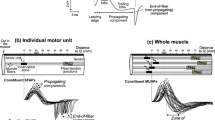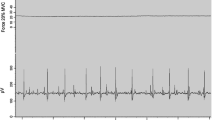Abstract
Purpose
We investigated the recovery of muscle electrical properties after intermittent intense exercise by examining separately the first and second phases of the muscle compound action potential (M-wave).
Methods
M-waves and mechanical twitches were obtained using femoral nerve stimulation throughout the 30-min recovery period following 48 successive intermittent 3-s MVCs. The amplitude, duration, and area of the M-wave first and second phases, and the peak twitch force were measured from the knee extensors.
Results
The amplitudes of both the first and second M-wave phases were increased immediately after exercise (P < 0.05), but, whereas the first phase remained enlarged for 5 min after exercise, the increase of the second phase only lasted for 10 s. After 30 min of recovery, the amplitude, area, and duration of both the first and second phases were decreased compared to control values (10–20%, P < 0.05). A significant temporal association was found between the changes in the amplitude and duration of the M-wave first phase (maximal cross correlations, 0.9–0.93; time lag, 0 s). A significant, negative temporal relation was found between the amplitude of the M-wave first phase and the peak twitch force during recovery (P < 0.05).
Conclusions
The prolonged enlargement of the M-wave first phase during recovery seems primarily related to fatigue-induced changes in membrane properties, whereas the extremely short recovery of the second phase might be related to changes in muscle architectural features. It is concluded that muscle excitability is impaired even after intermittent fatiguing contractions which allow partial clearance of extracellular K+.






Similar content being viewed by others
Abbreviations
- AmpliFIRST :
-
Amplitude of the first phase of the M-wave
- AmpliSECOND :
-
Amplitude of the second phase of the M-wave
- AmpliPP :
-
Amplitude resulting from the sum of AmpliFIRST and AmpliSECOND
- AreaFIRST :
-
Area of the first phase of the M-wave
- AreaSECOND :
-
Area of the second phase of the M-wave
- AreaTOTAL :
-
Area resulting from the sum of AreaFIRST and AreaSECOND
- DurFIRST :
-
Duration of the first phase of the M-wave
- DurSECOND :
-
Duration of the second phase of the M-wave
- DurPP :
-
Time interval between the first and second peaks of the M-wave
- MVC:
-
Maximal voluntary contraction
- M-wave:
-
Compound muscle action potential
- SD:
-
Standard deviation
- SE:
-
Standard error of the mean
- EMG:
-
Electromyography
- VL:
-
Vastus lateralis
- VM:
-
Vastus medialis
- RF:
-
Rectus femoris
References
Arabadzhiev TI, Dimitrov GV, Chakarov VE, Dimitrov AG, Dimitrova NA (2008) Effects of changes in intracellular action potential on potentials recorded by single-fiber, macro, and belly-tendon electrodes. Muscle Nerve 37:700–712
Bellemare F, Garzaniti N (1988) Failure of neuromuscular propagation during human maximal voluntary contraction. J Appl Physiol 64(3):1084–1093
Beretta Piccoli M, Rainoldi A, Heitz C, Wüthrich M, Boccia G, Tomasoni E, Spirolazzi C, Egloff M, Barbero M (2014) Innervation zone locations in 43 superficial muscles: toward a standardization of electrode positioning. Muscle Nerve 49(3):413–421
Bigland-Ritchie B, Kukulka CG, Lippold OC, Woods JJ (1982) The absence of neuromuscular transmission failure in sustained maximal voluntary contractions. J Physiol 330:265–278
Botter A, Oprandi G, Lanfranco F, Allasia S, Maffiuletti NA, Minetto MA (2011) Atlas of the muscle motor points for the lower limb: implications for electrical stimulation procedures and electrode positioning. Eur J Appl Physiol 111:2461–2471
Bruton JD, Westerblad H, Katz A, Lännergren J (1996) Augmented force output in skeletal muscle fibres of Xenopus following a preceding bout of activity. J Physiol 493:211–217
Crone C, Johnsen LL, Hultborn H, Orsnes GB (1999) Amplitude of the maximum motor response (Mmax) in human muscles typically decreases during the course of an experiment. Exp Brain Res 124(2):265–270
Cupido CM, Galea V, McComas AJ (1996) Potentiation and depression of the M-wave in human biceps brachii. J Physiol 491(2):541–550
Dimitrova NA, Dimitrov GV (2002) Amplitude-related characteristics of motor unit and M-wave potentials during fatigue. A simulation study using literature data on intracellular potential changes found in vitro. J Electromyogr Kinesiol 12:339–349
Duchateau J, Hainaut K (1985) Electrical and mechanical failures during sustained and intermittent contractions in humans. J Appl Physiol 58:942–947
Fowles JR, Green HJ, Tupling R, O’Brien S, Roy BD (2002) Human neuromuscular fatigue is associated with altered Na+–K+-ATPase activity following isometric exercise. J Appl Physiol 92(4):1585–1593
Hanson J, Persson A (1971) Changes in the action potential and contraction of isolated frog muscle after repetitive stimulation. Acta Physiol Scand 81:340–348
Hanson J (1974) Effects of repetitive stimulation on membrane potentials and twitch in human and rat intercostal muscle fibers. Acta Physiol Scand 92:238–248
Hara T (1980) Evaluation of recovery from local muscle fatigue by voluntary test contractions. J Hum Ergol 9(1):35–46
Hicks A, Fenton J, Garner S, McComas AJ (1989) M wave potentiation during and after muscle activity. J Appl Physiol 66:2606–2610
Juel C (1988) Muscle action potential propagation velocity changes during activity. Muscle Nerve 11:714–719
Keenan KG, Farina D, Merletti R, Enoka RM (2006) Influence of motor unit properties on the size of the simulated evoked surface EMG potential. Exp Brain Res 169:37–49
Kubo K, Kanehisa H, Kawakami Y, Fukunaga T (2001) Influences of repetitive muscle contractions with different modes on tendon elasticity in vivo. J Appl Physiol 91:277–282
Lännergren J, Westerblad H (1987) Action potential fatigue in single skeletal muscle fibres of Xenopus. Acta Physiol Scand 129:311–318
Lännergren J, Larsson L, Westerblad H (1989) A novel type of delayed tension reduction observed in rat motor units after intense activity. J Physiol 412:267–276
Lateva ZC, McGill KC (1998) The physiological origin of the slow afterwave in muscle action potentials. Electroencephalogr Clin Neurophysiol 109(5):462–469
Lateva ZC, McGill KC, Burgar CG (1996) Anatomical and electrophysiological determinants of the human thenar compound muscle action potential. Muscle Nerve 19(11):1457–1468
Lindinger MI (1995) Potassium regulation during exercise and recovery in humans: implications for skeletal and cardiac muscle. J Mol Cell Cardiol 27(4):1011–1022
Lüttgau HC (1965) The effect of metabolic inhibitors on the fatigue of the action potential in single muscle fibres. J Physiol (Lond) 178:45–67
Maganaris CN, Baltzopoulos V, Sargeant AJ (2002) Repeated contractions alter the geometry of human skeletal muscle. J Appl Physiol 93:2089–2094
McFadden LK, McComas AJ (1996) Late depression of muscle excitability in humans after fatiguing stimulation. J Physiol 496(Pt 3):851–855
Metzger JM, Fitts RH (1986) Fatigue from high- and low frequency muscle stimulation: role of sarcolemma action potentials. Exp Neurol 93:320–333
Millet GY, Martin V, Martin A, Vergès S (2011) Electrical stimulation for testing neuromuscular function: from sport to pathology. Eur J Appl Physiol 111(10):2489–2500
Milner-Brown HS, Miller RG (1986) Muscle membrane excitation and impulse propagation velocity are reduced during muscle fatigue. Muscle Nerve 9(4):367–374
Overgaard K, Nielsen OB, Flatman JA, Clausen T (1999) Relations between excitability and contractility in rat soleus muscle: role of the Na+–K+ pump and Na+/K+ gradients. J Physiol 518(Pt 1):215–225
Partovi S, Aschwanden M, Jacobi B, Schulte AC, Walker UA, Staub D, Imfeld S, Broz P, Benz D, Zipp L, Jaeger KA, Takes M, Robbin MR, Huegli RW, Bilecen D (2013) Correlation of muscle BOLD MRI with transcutaneous oxygen pressure for assessing microcirculation in patients with systemic sclerosis. J Magn Reson Imaging 38(4):845–851
Place N, Yamada T, Bruton JD, Westerblad H (2010) Muscle fatigue: from observations in humans to underlying mechanisms studied in intact single muscle fibres. Eur J Appl Physiol 110(1):1–15
Rodriguez-Falces J, Place N (2014) Effects of muscle fibre shortening on the characteristics of surface motor unit potentials. Med Biol Eng Comput 52:95–107
Rodriguez-Falces J (2016) The formation of extracellular potentials over the innervation zone: Are these potentials affected by changes in fibre membrane properties? Med Biol Eng Comput 54(12):1845–1858
Rodriguez-Falces J, Place N (2017) New insights into the potentiation of the first and second phases of the M-wave after voluntary contractions in the quadriceps muscle. Muscle Nerve 55(1):35–45
Rodriguez-Falces J, Duchateau J, Muraoka Y, Baudry S (2015) M-wave potentiation after voluntary contractions of different durations and intensities in the tibialis anterior. J Appl Physiol 118:953–964
Thomas CK, Woods JJ, Bigland-Ritchie B (1989) Impulse propagation and muscle activation in long maximal voluntary contractions. J Appl Physiol 67:1835–1842
Van der Hoeven JH, van Weerden TW, Zwarts MJ (1993) Long-lasting supernormal conduction velocity after sustained maximal isometric contraction in human muscle. Muscle Nerve 16:312–320
West W, Hicks A, McKelvie R, O’Brien J (1996) The relationship between plasma potassium, muscle membrane excitability and force following quadriceps fatigue. Pflugers Arch 432:43–49
Author contribution
JRF and NP designed experimental study; JRF performed experiments; JRF analyzed data; JRF and NP interpreted results of experiments; JRF drafted manuscript; JRF and NP edited and revised manuscript; JRF and NP approved final version of manuscript.
Author information
Authors and Affiliations
Corresponding author
Ethics declarations
Conflict of interest
The authors declare that they have no conflict of interest.
Additional information
Communicated by Olivier Seynnes.
Rights and permissions
About this article
Cite this article
Rodriguez-Falces, J., Place, N. Different recoveries of the first and second phases of the M-wave after intermittent maximal voluntary contractions. Eur J Appl Physiol 117, 607–618 (2017). https://doi.org/10.1007/s00421-017-3553-9
Received:
Accepted:
Published:
Issue Date:
DOI: https://doi.org/10.1007/s00421-017-3553-9




